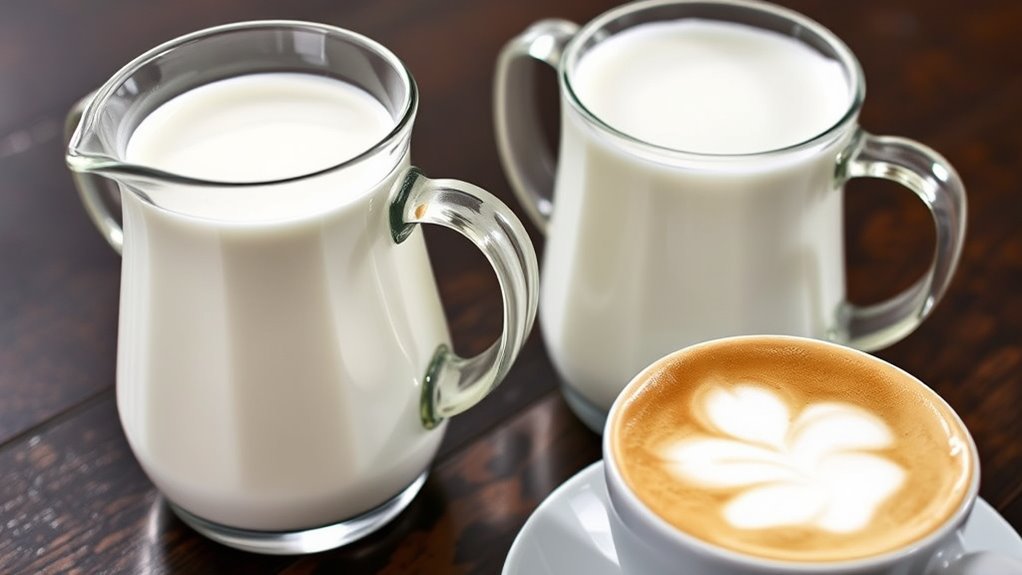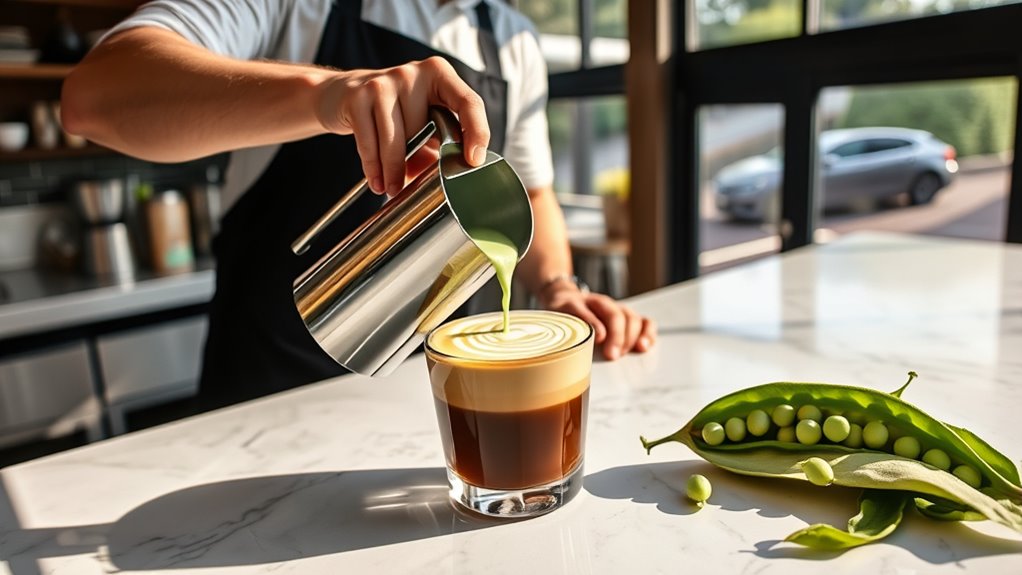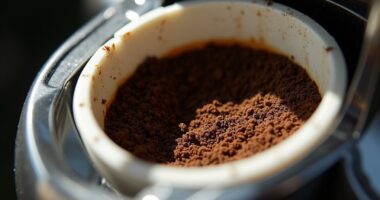When it comes to cappuccinos, whole milk is the classic go-to! It froths beautifully, creating that luscious foam we all love. If you’re feeling adventurous, try oat or almond milk; they’re trendy and tasty alternatives. Low-fat options like 1% or skim milk are lighter but still deliver flavor. Just know that each milk brings its own vibe, so don’t be shy—experiment a bit! Stick around, and you’ll discover some tips on frothing techniques next.
At a Glance
- Whole milk is ideal for cappuccinos due to its rich texture, creamy foam, and flavor-enhancing properties.
- Low-fat milk options like 1% or skim provide lighter drinks while still offering good frothing capabilities.
- Oat milk is an excellent dairy alternative, providing creamy texture and natural sweetness, perfect for frothing.
- Soy and almond milk are popular non-dairy choices, with soy being high in protein and almond being low in calories.
- Experimenting with different milks can enhance flavor profiles and cater to individual taste preferences and dietary needs.
Whole Milk: The Classic Choice

When you think about the perfect cappuccino, whole milk is usually the star of the show—it’s like the warm hug your coffee needs!
Whole milk benefits your brew by adding a rich, creamy texture and a subtle sweetness that can’t be beat. Remember sipping that classic cappuccino, with its velvety foam just begging for a sprinkle of cocoa? That’s the cappuccino tradition at work!
The higher fat content not only makes the drink smoother but also stabilizes the foam, keeping it gorgeous. Additionally, milk’s frothing capabilities are enhanced by its fat content, making whole milk an exceptional choice for achieving that perfect froth.
2% Milk: A Creamy Alternative
If whole milk is the classic hug for your cappuccino, then alternative milks are like that quirky, fun friend who adds a twist to the experience!
Soy milk brings a nutty punch, while almond milk keeps it light and breezy. Oat milk shines with its creamy texture, frothing beautifully for that dreamy cappuccino.
Soy milk adds a delightful nuttiness, almond milk offers a breezy lightness, and oat milk delivers creamy perfection for your cappuccino!
Coconut milk? Oh, it’s rich and full-bodied, perfect for those decadent sips. Cashew milk gives you that luxurious feel without overpowering flavors.
Each of these options not only adds a creamy texture but also enhances the flavor, making your coffee adventure way more exciting! Plus, many of these alternatives are non-dairy creamers that cater to a variety of dietary preferences.
Low-Fat Options: 1% and Skim Milk

While you might be tempted to stick with whole milk for your cappuccino, low-fat options like 1% and skim milk can actually bring a fun twist to your coffee game!
They pack some low fat benefits, making your drink lighter without sacrificing flavor. Plus, milk frothing with these options is a breeze!
- Skim milk froths like a pro, giving you a stable foam.
- 1% milk adds a hint of sweetness, perfect for a cozy vibe.
- Both options are rich in calcium, so you’re doing your bones a favor!
Using a standalone milk frother can enhance your frothing experience and help you achieve the perfect texture.
Give them a shot—you might just fall in love!
The Rise of Oat Milk
You might think that milk options for your cappuccino are limited to the usual suspects, but here comes oat milk, ready to shake things up!
With its creamy microfoam and natural sweetness, it’s perfect for those cozy café vibes. Plus, oat milk has some serious sustainability benefits, like a lower carbon footprint than cow’s milk.
It’s also great for anyone avoiding dairy, so everyone can join the cappuccino party! Just look for barista blends that froth up nicely, and you’re golden.
Give oat milk a try—you might just find your new favorite! Who knew being eco-friendly could taste so good? Additionally, oat milk can provide a rich texture that enhances the overall flavor of your beverage.
Soy Milk: A Nutty Addition

When it comes to cappuccinos, soy milk is like that quirky friend who always brings something unique to the table.
It’s packed with soy health benefits, offering a nutty flavor that complements your coffee perfectly. Plus, those frothing techniques? They create a creamy texture that’ll wow your taste buds!
- It’s low in sugar and high in protein, keeping your energy up.
- Fortified with calcium, it’s great for your bones!
- A favorite among baristas for its frothing potential.
Additionally, soy milk can be a fantastic alternative to traditional dairy, making it a popular choice for those seeking a dairy-free option in their coffee.
Almond Milk Barista Blends
Almond milk barista blends are like the superheroes of the non-dairy world! They froth and foam like dairy milk, making your cappuccinos creamy and delicious.
You’ll love how they create thick microfoam that’s perfect for latte art—talk about impressing your friends! Plus, they blend seamlessly into hot or iced coffee without any weird separation.
With a subtle almond flavor, they let your espresso shine while keeping things smooth. And hey, they’re low in calories and free from common allergens, so everyone can enjoy them.
Did you know that ground coffee can enhance the overall taste of your cappuccino? You might just find your new favorite coffee partner in these tasty blends!
Pea Milk: The Emerging Contender

Pea milk is quickly becoming the cool kid on the block in the world of plant-based milks!
It’s not just fun to say; it’s packed with sustainability benefits and barista preferences. You’ll love how it froths up beautifully, creating that perfect cappuccino foam without overpowering your coffee’s flavor.
- Rich in protein, so it froths like a champ!
- Allergen-free, making it a safe choice for everyone.
- Eco-friendly, using less land and water in production. Additionally, many coffee enthusiasts are making the switch to low acid coffee for a smoother taste experience.
Frothing Techniques for Different Milk Types
So, you’ve picked out your favorite milk for that cappuccino, but now it’s time to master the frothing game!
To start, position your steam wand just below the milk surface. This creates a whirlpool that’s pure magic. Keep that milk temperature between 140-155°F for the best frothing techniques.
Don’t forget to let in some air as you froth—aim for that silky microfoam that makes you feel like a barista superstar! Additionally, using a perfect at-home milk steamer can significantly enhance your frothing results.
Experiment with timing and technique for different milks. With a little practice, you’ll be serving up frothy perfection that’ll make your friends jealous.
Cheers to delicious cappuccinos!
Impact of Milk Processing on Flavor

When you’re whipping up a cappuccino and choosing your milk, remember that how it’s processed can totally change the flavor game.
The way milk’s processed affects sweetness and texture, which can make or break your drink. Here’s what to keep in mind:
- Pasteurized milk amps up those sweet notes, while UHT can leave a flat taste.
- Full-fat milk gives you a creamy mouthfeel, while low-fat can feel a bit thin.
- Unprocessed milk usually interacts better with espresso, creating a more vibrant flavor profile.
Additionally, using coconut milk coffee creamer can add a unique twist to your cappuccino while enhancing its overall richness.
Nutritional Considerations for Milk Choices
Choosing the right milk for your cappuccino can feel like a mini adventure, especially with all the options out there!
Let’s chat about nutrient density and calorie comparison. Whole milk gives you that creamy goodness, but if you’re counting calories, skim or almond milk might be your best buds. Skim milk packs in protein without the extra fat, while almond milk keeps things light and breezy.
Oat milk? It’s rich in fiber but can tip the calorie scale. Remember, fortified plant milks can match dairy’s nutrients, so read those labels! Additionally, the type of coffee bean used can also influence how well the milk complements the drink, so consider exploring the perfect coffee bean for your cappuccino.
Pick what makes your taste buds dance and your body happy!





